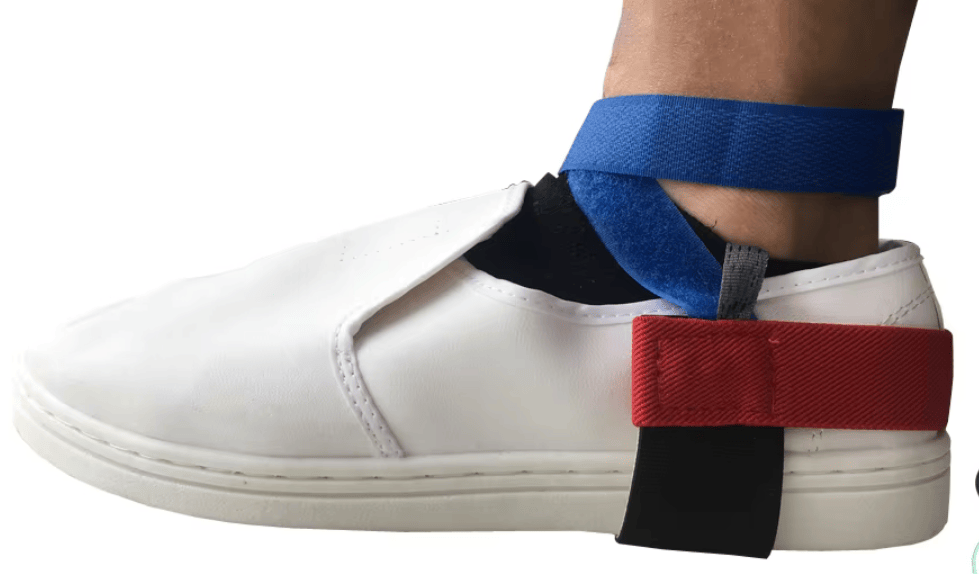ESD Shoe Straps


ESD Shoe Straps Detials:
1. esd shoe strap allow freedom of movement around the shop environment without the restriction of a wrist strap ground cord leashing you to a bench.
2. The nylon ribbon should make contact with skin, or at minimum, with the sweaty moisture in your shoe in order to provide a path to ground for the static electricity.
3. Anti-static foot grounder avoids the earthing line when walking in the range of conductive area and is the best choice of workshop and garage.
4. The principle is that the earthing line in socks will remove static of body through earthing foot grounder,esd mat and the earthing line. So the earthling line must contact with skin.
5. The user should wear the two-foot grounder and avoid walking on the area without static protection.
Specification
| Product name | ESD Shoe Straps |
| Model number | EF-9090 |
| Material | Conductive synthetic rubber |
| Color | Blue+black |
| Balck conductive layer | 10^3~10^5 ohms |
| Blue conductive layer | 10^8~10^9 ohms |
| Conductive belt length | 400-450mm |
| Static decay time | 0.1(sec) |
| Keywords | ESD foot strap |
| Type | Ankle type |
| Feacture | Anti-static |
| Application | Electronics factory |
Features:
• Each heel grounder incorporates a 1 Meg Ohm safety
resistor
• All Heel Grounders are designed for use in conjunction
with ESD flooring mats
• Recommended to be worn on both feet
• Reusable and can be washed by hand in mild detergents
• Conforms to the requirements of ANSI/ESD S-20.20
• Hard wearing heel grounders designed for long term use
ESD heel strap or called esd straps for shoes discharge static from a person to ground by connecting the person to a grounded walking surface. A conductive ribbon placed inside the wearer’s shoe or sock makes electrical contact with the skin through perspiration. The ribbon is joined to a resistor which limits current should accidental exposure to electricity occur. The other end of the resistor is joined to a conductive sole. This sole contacts a grounded ESD floor mat or ESD flooring system. Foot grounders must be worn on both feet to maintain ground contact while walking.
What Are ESD Shoe Straps?
ESD shoe straps (also called 3m esd shoe straps or heel grounders or heel straps) are anti-static grounding devices worn over regular footwear to safely dissipate electrostatic charges from the human body to the ground, electrostatic discharge esd wrist or shoe strap,protecting sensitive electronic components from Electrostatic Discharge (ESD) damage. These are essential in ESD-protected areas (EPA) where full ESD shoes may not be required or practical.
Main Components
An ESD shoe strap typically includes:
Conductive rubber strap: Makes contact with the floor.
Elastic band or Velcro loop: Secures the strap around the heel or foot.
Conductive ribbon (inner ribbon): Tucks into the sock to make contact with the skin, allowing body charge to pass through the strap.
Working Principle
The human body can build up thousands of volts of static electricity simply by walking. In ESD-sensitive environments, this charge can damage microchips, semiconductors, or printed circuit boards (PCBs). The ESD shoe strap grounds the body by providing a resistive path (typically 1 MΩ) from the skin to the ESD floor, allowing the static charge to dissipate safely and slowly.
Typical Use Cases
Electronics manufacturing
Semiconductor assembly
Medical device production
Cleanroom environments
Laboratories and repair centers
how to wear esd shoe strap?
Place the heel cup (conductive rubber section) on the sole of the shoe, under the heel.
Wrap the Velcro or elastic strap around the heel to keep it secure.
Insert the conductive ribbon into your sock, ensuring direct contact with the skin.
Walk only on ESD-safe flooring (conductive or dissipative) for proper grounding.
Test regularly using an ESD tester to confirm continuity and proper grounding.
Performance Standards
Most ESD shoe straps comply with international standards, such as:
ANSI/ESD S20.20
IEC 61340-5-1
MIL-STD-1686
They are required to provide:
Resistance to ground between 1 × 10⁶ and 1 × 10⁹ ohms
Consistent contact between the body, the strap, and the floor
Advantages
✅ Cost-effective alternative to ESD shoes
✅ Easy to install and use
✅ One-size-fits-all
✅ Ideal for occasional visitors to EPA zones
✅ Lightweight and comfortable
Limitations and Precautions
❌ Only effective on ESD-safe floors
❌ Must make direct contact with skin
❌ Need to be worn on both feet for full effectiveness (two-point contact grounding)
❌ Require frequent testing to ensure proper function
❌ Not suitable for cleanroom environments without specific certification
Care and Maintenance
Clean the conductive rubber regularly to prevent build-up of dust or oils.
Replace if the strap is damaged, worn, or fails an ESD tester check.
Store in a dry place to preserve conductivity.
Summary
| Feature | Description |
|---|---|
| Purpose | Prevent electrostatic discharge to sensitive equipment |
| Use | Worn on footwear, connects to skin via conductive ribbon |
| Cost | Low |
| Compliance | ANSI/ESD, IEC standards |
| Effective with | ESD floors and regular testing |
| Limitations | Must have skin contact and both-foot use |
where to buy esd shoe straps?
Would you like help choosing a model or brand of ESD shoe straps,contact with us -ESD Factorys
Our product include : esd disposable shoe strap,esd grounding shoe straps,esd grounding shoe straps,esd shoes strap,esd shoes vs straps,esd strap for shoes,in shoe esd strap
